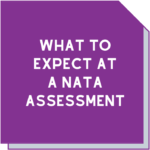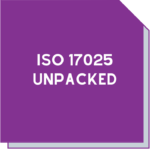Let’s talk about NATA accreditation

Our guidance document Navigating the NATA accreditation maze was written to provide an overview of the NATA accreditation process.
However, we thought that a little more detail would be helpful if you’re looking to start down this path.
And for those labs already holding NATA accreditation, there’s some hints for you as well.
Know your why
Gaining and maintaining accreditation takes a substantial time and financial investment. Before heading off on this journey you should be clear on why you’re doing it.
Is your reason customer driven? If so, this will help you decide which tests and methods you can request on your Scope of Accreditation with NATA. Remember, not all of your tests and methods need to be accredited.
If it’s not because of your customers or mandated, then consider carefully what you hope to gain by achieving accreditation.
Get ready to read
There’s plenty of information on the NATA website about how to become accredited. You could contact them directly and ask them to point you in the right direction in terms of technical requirements. This could also be a good time to ask about a cost estimate for the process.
Once you have all this information, you’re in for some serious reading! You’ll need to determine if your lab meets the criteria and identify any areas where it may not.
This would be the perfect time to contact MAS and discuss a gap analysis visit.
Examining your quality system
The gap analysis will have shown you where you are missing processes or procedures in your system. Remember, your quality system extends to the ‘technical’ parts of your work, including methods, staff, and equipment.
You may have an excellent system in place, but the documentation is letting you down. Or you may have a series of documents on processes but they’re out-of-date.
Again, MAS can help with this by helping to capture and refine your processes into documents, carrying out an internal audit or training your staff to do them.
NATA advisory visit
Is your system ready for examination? Then it’s time for a NATA advisory visit.
This is an opportunity for NATA to give you feedback on your system and check if there are any gaps.
The Assessment
If there were any issues raised during the advisory visit, sort these out well in advance of the assessment. In fact, may have to demonstrate that you’ve sorted out these issues before NATA will organise an assessment.
This will include a Technical Assessor with industry knowledge. The Technical Assessor will examine the technical aspects of your lab while the NATA staff member will review your quality system.
NATA will leave you with an assessment report which includes any nonconformances, known as ‘conditions for accreditation’. You’ll need to address all of these before being granted accreditation.
Accreditation
CONGRATULATIONS, you did it!! You’ll receive a certificate from NATA which includes your Scope of Accreditation.
You’ll now be able to issue reports with the NATA endorsement (be sure to read through the NATA Rules and comply with the requirements).
Continuing accreditation
There will be regular NATA visits to check that your lab and quality system haven’t ‘drifted’ since your initial visit.
Surveillance visits with a NATA staff member occur after 1.5 years. At the three-year mark, expect a full reassessment with a Technical Assessor.
Are you accredited?
Once you hold accreditation and have settled into a maintenance routine, you may find additional tests or calibrations you want to add to your scope.
Since you’re already in the accreditation ‘groove’ this shouldn’t be too difficult. Remember you’ll still need to cover the accreditation requirements laid out by NATA and the applicable standard.
But there are some things you need to consider. For example, how different from your current scope of accreditation is the additional work? If its quite different, such as a completely different scientific discipline, then there will be more effort involved in getting accredited for this work than if you were working within the same discipline. And when we say ‘discipline’, we’re talking about high level categories such as Chemistry, Biology, Molecular Biology, Nanotechnology, Physics, and Electrical Engineering.
You can apply to NATA for an addition to your scope at any time. Submit your application form along with supporting documents. NATA will review this and let you know what type of assessment activity you need.
The same form can be used for deleting tests from your scope.
WHY would you delete tests after going through this whole process, you ask? Because businesses change.
You may have tests on your original scope that you no longer carry out. Or they could be extremely infrequent. Or perhaps your clients no longer require accreditation for those particular tests. Rather than carrying them on your scope (and paying for them!) removing them could be the best option.
How can we help?
We can be there for you at every step of this process!
Our gap analysis and system audit of your system will ensure that your assessment team will see the very best version of your system.
We have a range of training courses to support you and your staff and ensure that things like your measurement uncertainty, traceability, internal audit and root cause analysis skills are up to scratch.
And our services in documenting your system can take the pain out of preparing the paperwork in an efficient and effective manner.
We can even be there on assessment day to support your team and, if necessary, to advocate on your behalf.
Contact Maree on 0411 540 709 or email info@masmanagementsystems.com.au to arrange a confidential discussion.
Remember, you don’t have to do this alone!
Download the article Let’s talk about NATA accreditation
People who read this article also enjoyed:





